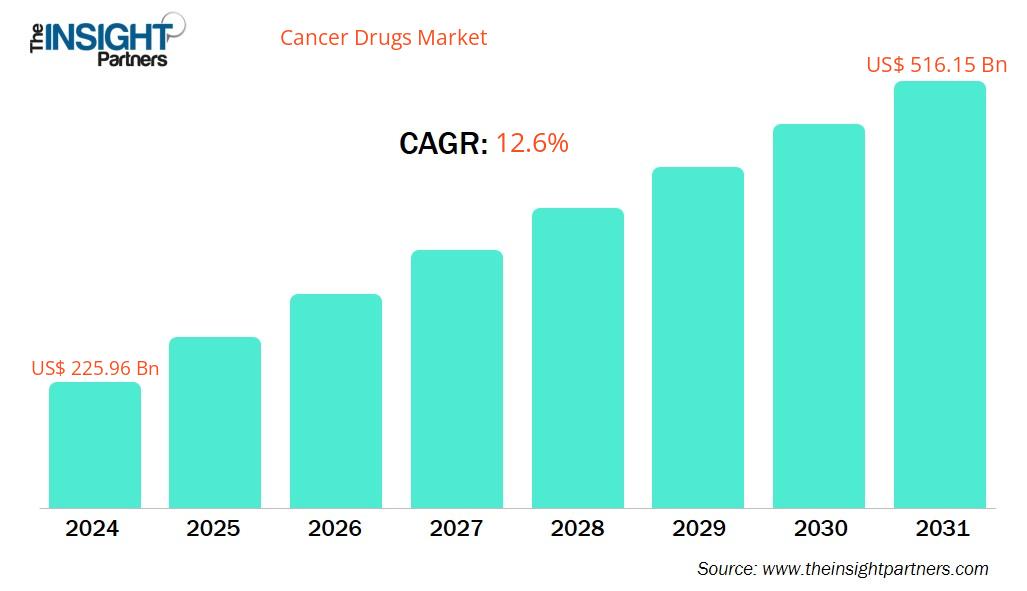预计抗癌药物市场规模将从 2024 年的 2259.6 亿美元增至 2031 年的 5161.5 亿美元。预计2025 年至 2031 年期间的复合年增长率为 12.60%。
抗癌药物市场分析
乳腺癌和肺癌的负担日益加重,以及肿瘤学研究投入的激增,推动了抗癌药物的使用。抗癌药物是用于治疗癌症的药物。它们通过各种机制发挥作用,包括直接靶向癌细胞、阻止其生长和扩散,或刺激人体免疫系统攻击癌细胞。这些药物根据其作用机制分为不同类型,可以单独使用或联合使用。
此外,政府和私人组织支持的增加为抗癌药物市场带来了重大机遇,也是推动市场增长的关键因素。
抗癌药物市场概况
预计北美将占据抗癌药物市场最大份额,而亚太地区预计在预测期内将实现显著的复合年增长率。亚太地区的抗癌药物市场正经历快速增长,这主要得益于几个关键因素。该地区包括中国、日本、印度、韩国、澳大利亚等主要国家以及更广泛的亚太地区,每个国家都为市场扩张做出了贡献。北美,尤其是美国,癌症发病率很高。此外,大量的老年人口也面临着更大的癌症风险。癌症病例的不断增加刺激了对先进疗法和治疗方案的需求。
此外,癌症病例的不断增加也刺激了对先进疗法和治疗方案的需求。该地区的技术进步和经济高效的生产使企业能够以具有竞争力的价格生产高效的药物,从而进一步提升其市场占有率。
政府机构正在通过实施亲民的报销政策和其他医疗保健举措,为癌症治疗提供令人满意的费用覆盖,使癌症治疗变得触手可及。
您可以免费定制任何报告,包括本报告的部分内容、国家级分析、Excel 数据包,以及为初创企业和大学提供优惠和折扣
抗癌药物市场:战略洞察

-
获取此报告的顶级关键市场趋势。此免费样品将包括数据分析,从市场趋势到估计和预测。
抗癌药物市场驱动因素和机遇
市场驱动因素:
-
乳腺癌和肺癌负担日益加重:
乳腺癌和肺癌的发病率日益上升,是推动抗癌药物市场发展的重要因素。此外,民众对癌症认知的不断提升,预计将对这一市场的发展做出积极贡献。 -
肿瘤学研究投资激增:
随着对更有效、更有针对性的癌症治疗的需求不断增长,研发活动已成为发现创新药物和治疗策略的基础。 -
精准医疗的进展:
许多新型抗癌药物,尤其是生物制剂和细胞疗法,价格高昂。这加剧了人们对负担能力的担忧,给公共卫生预算带来了压力,并造成了药物可及性的差异。付款人和政府越来越多地评估基于价值的定价,引发了关于定价透明度、报销模式和全球成本控制政策的争论。
市场机会:
-
增加政府和私人组织的支持:
一些政府和私人组织增加了对癌症治疗研发的资金投入,从而促进了创新药物和疗法的开发。
-
技术进步
该地区的技术进步和具有成本效益的制造使公司能够以具有竞争力的价格生产创新药物,从而进一步增强其市场占有率。
-
新兴经济体的扩张:
由于癌症病例数量不断增加以及人们对癌症的认识不断提高,亚太、拉丁美洲和非洲的几个国家在抗癌药物市场提供了增长机会。 -
医疗旅游的兴起:
中国、印度、印度尼西亚、巴西和墨西哥等发展中国家的医疗旅游业日益繁荣,这些国家提供价格合理的先进护理和治疗,费用比美国和欧洲国家低 30% 至 80%。
抗癌药物市场报告细分分析
为了更清晰地了解抗癌药物市场运作方式、增长潜力和最新趋势,我们将抗癌药物市场划分为不同的细分市场。以下是大多数行业报告中使用的标准细分方法:
按治疗类型:
-
化疗:
化疗药物主要针对快速分裂的细胞,也会影响健康、快速生长的细胞,如毛囊、消化系统和骨髓。 -
靶向治疗:
靶向药物通过破坏或减缓癌细胞生长来抑制癌细胞生长。靶向治疗与传统化疗联合使用。 -
免疫疗法:
免疫疗法利用个体的免疫系统有效识别并摧毁癌细胞。它通常针对人体免疫系统中的特定蛋白质,以增强免疫反应。 -
激素疗法:
激素疗法(激素疗法、激素阻断疗法或内分泌疗法)是一种癌症治疗方法,旨在减缓或阻止依赖激素发展的癌细胞的生长。 -
其他治疗类型:
基因治疗、癌症疫苗和表观遗传治疗是癌症治疗中最具创新性和最有前景的方法。
按适应症:
-
血癌:
由于靶向治疗、免疫疗法和个性化医疗的进步,血癌药物市场显著增长。 -
肺癌:
随着治疗方式的快速进步,肺癌药物市场持续发展。靶向疗法、免疫疗法和精准医疗正在重塑肺癌治疗的格局。 -
乳腺癌:
乳腺癌药物市场的特点是拥有多种可用和正在开发的治疗方式;这些有前景的治疗选择包括靶向治疗、激素治疗、免疫疗法和精准医疗,它们正在改变市场动态并为不同阶段和亚型的乳腺癌患者带来希望。 -
结直肠癌:
结直肠癌药物市场由持续的研究和开发创新疗法来改善患者的治疗效果所驱动。 -
前列腺癌:
就发病率和死亡率而言,前列腺癌是全球男性最常见的癌症类型中第二大癌症,仅次于肺癌。 -
胃癌:
胃癌,又称胃癌,是全球第五大常见癌症。近年来,科学和临床的发展正在改变胃癌的诊断和治疗格局。 -
宫颈癌:
宫颈癌是全球女性最常见的癌症类型之一。尽管由于广泛且积极的HPV疫苗接种计划和宫颈筛查,许多发达国家的宫颈癌发病率有所下降,但宫颈癌仍然是一项重大的健康挑战,尤其是在中低收入国家。 -
肝脏和肝内胆管癌:
癌症药物市场中的肝脏和肝内胆管部分至关重要,因为肝脏和胆管癌是最具侵袭性和治疗难度的癌症之一,因为它们通常在晚期才被诊断出来。 -
甲状腺癌:
甲状腺癌虽然与其他癌症相比相对罕见,但却是最常见的内分泌恶性肿瘤,包括乳头状癌、滤泡状癌、髓样癌和未分化甲状腺癌等亚型。 -
其他适应症:
其他适应症主要包括子宫体癌、口腔癌、皮肤癌黑色素瘤、卵巢癌、喉癌等。
按分销渠道:
- 医院药房
- 零售药店
- 网上商店
按地域划分:
- 北美
- 欧洲
- 亚太地区
- 拉美
- 中东和非洲
北美抗癌药物市场预计将占据相当大的市场份额。癌症发病率的上升以及市场参与者的业务扩张战略可能是推动市场发展的因素。
抗癌药物市场区域洞察
Insight Partners 的分析师已详尽阐述了预测期内影响抗癌药物市场的区域趋势和因素。本节还讨论了北美、欧洲、亚太地区、中东和非洲以及南美和中美洲的抗癌药物市场细分和地域分布。
抗癌药物市场报告范围
| 报告属性 | 细节 |
|---|---|
| 2024年的市场规模 | 2259.6亿美元 |
| 2031年的市场规模 | 5161.5亿美元 |
| 全球复合年增长率(2025-2031) | 12.6% |
| 史料 | 2021-2023 |
| 预测期 | 2025-2031 |
| 涵盖的领域 |
按治疗类型
|
| 覆盖地区和国家 |
北美
|
| 市场领导者和主要公司简介 |
|
抗癌药物市场参与者密度:了解其对业务动态的影响
抗癌药物市场正在快速增长,这得益于终端用户需求的不断增长,而这些需求的驱动因素包括消费者偏好的转变、技术进步以及对产品益处的认知度的提升。随着需求的增长,企业正在扩展产品线,不断创新以满足消费者需求,并抓住新兴趋势,从而进一步推动市场增长。

- 了解抗癌药物市场主要参与者概况
抗癌药物市场份额地域分析
预计未来几年亚太地区将增长最快。拉丁美洲、中东和非洲等新兴市场也为抗癌药物供应商提供了许多尚未开发的扩张机会。
各地区抗癌药物市场的增长情况各不相同。这受多种因素影响,例如癌症发病率上升、肿瘤学研究投入激增以及创新肿瘤药物的采用率不断提高。以下是各地区市场份额和趋势的总结:
1. 北美
-
市场份额:
占据全球市场的很大份额 -
关键驱动因素:
- 乳腺癌和肺癌的负担日益加重。
- 肿瘤学研究投资激增
- 个性化医疗的增长
-
趋势:
抗癌药物制造商采用有机和无机策略。
2.欧洲
-
市场份额:
由于早期采用数字商务而占据相当大的份额 -
关键驱动因素:
- 癌症发病率上升
- 政府对抗癌药物的严格监管
-
趋势:
抗癌药物的技术进步
3. 亚太地区
-
市场份额:
增长最快的地区,市场份额逐年上升 -
关键驱动因素:
- 在政府加大公共卫生投入的支持下,医疗基础设施得到快速改善。
- 公众和各机构对抗癌药物的认识不断提高。
-
趋势:
医疗旅游兴起
4.南美洲和中美洲
-
市场份额:
市场稳步增长 -
关键驱动因素:
- 癌症病例不断增加
- 药品进口增加
-
趋势:
医疗旅游兴起
5.中东和非洲
-
市场份额:
虽然规模小,但增长迅速 -
关键驱动因素:
- 扩大医疗保健基础设施
- 医疗保健机构对抗癌药物的认识不断提高
-
趋势:
政府提高抗癌药物认识的举措。
抗癌药物市场参与者密度:了解其对业务动态的影响
市场密度高,竞争激烈
由于罗氏、辉瑞、诺华、默克、百时美施贵宝、艾伯维、礼来、阿斯利康等知名企业的存在,竞争异常激烈。Novugen Pharma(马来西亚)和 Kalbe Farma(亚太地区)等区域性和利基供应商也加剧了不同地区的竞争格局。
这种激烈的竞争促使公司通过提供以下产品脱颖而出:
- 高级产品
- 竞争性定价模型
- 遵守监管指南
机遇与战略举措
- 专注于更有效、更有针对性的癌症疗法。癌症发病率的上升以及对先进疗法的需求,推动了研发投入的激增。
-
公司正在转向下一代肿瘤治疗和精准治疗,以解决监管和消费者对癌症治疗的担忧
- 专注于直接面向消费者的渠道,并加强电子商务平台的使用,以接触更广泛的客户群体。
在抗癌药物市场运营的主要公司有:
- 百时美施贵宝公司
- 艾伯维公司
- 强生公司
- F.霍夫曼-罗氏有限公司
- 辉瑞公司
- 阿斯利康公司
- 默克公司
- 诺华公司
- 安斯泰来制药公司
- 礼来公司
免责声明:以上列出的公司没有按照任何特定顺序排列。
研究过程中分析的其他公司:
- 武田药品工业株式会社
- 因塞特公司
- 吉利德科学公司
- 第一三共株式会社
- 鲁宾制药公司
- 益普生
- 勃林格殷格翰
- 格兰马克制药公司
- 吉利德科学
- 奥登生命科学
- Cytogen Pharmaceuticals印度私人有限公司
- 蓝鸟生物
- 百奥康有限公司
- 百济神州
- 安进公司
- 阿森迪斯制药
- 太阳制药工业
- 克洛维斯肿瘤学
- 西普拉有限公司
- 蓝图医药
抗癌药物市场新闻和最新发展
-
Glenmark 将在印度推出 DCGI 批准的抗癌药物
Glenmark Pharmaceuticals 即将在印度推出抗癌药物 zanubrutinib。此前,该药物已获得印度药品监督管理局 (Drugs Controller General of India) 的批准。该药物品牌名为 Brukinsa,用于治疗五种 B 细胞恶性肿瘤。
-
Truqap(capivasertib)联合 Faslodex 在美国获批用于治疗晚期 HR 阳性乳腺癌患者。
阿斯利康的 Truqap(capivasertib)与 Faslodex(氟维司群)联合使用已在美国获得批准,用于治疗激素受体(HR)阳性、HER2 阴性局部晚期或转移性乳腺癌成年患者,且该类乳腺癌具有一种或多种生物标志物改变(PIK3CA、AKT1 或 PTEN)。
抗癌药物市场报告覆盖范围和交付成果
《抗癌药物市场规模和预测(2021-2031)》报告对以下领域进行了详细的市场分析:
- 抗癌药物市场规模及全球、区域和国家层面所有主要细分市场的预测
- 抗癌药物市场趋势以及市场动态,例如驱动因素、限制因素和关键机遇
- 详细的 PEST 和 SWOT 分析
- 抗癌药物市场分析涵盖主要市场趋势、全球和区域框架、主要参与者、法规和最新市场发展
- 行业格局和竞争分析,包括市场集中度、热图分析、知名参与者以及抗癌药物市场的最新发展
- 详细的公司简介
- 历史分析(2 年)、基准年、预测(7 年)及复合年增长率
- PEST和SWOT分析
- 市场规模、价值/数量 - 全球、区域、国家
- 行业和竞争格局
- Excel 数据集
近期报告
客户评价
购买理由
- 明智的决策
- 了解市场动态
- 竞争分析
- 客户洞察
- 市场预测
- 风险规避
- 战略规划
- 投资论证
- 识别新兴市场
- 优化营销策略
- 提升运营效率
- 顺应监管趋势






















 获取免费样品 - 抗癌药物市场
获取免费样品 - 抗癌药物市场